BitFenix Ronin Case Review
by Dustin Sklavos on July 22, 2013 12:00 PM EST- Posted in
- Cases/Cooling/PSUs
- bitfenix
- ATX
Noise and Thermal Testing
The BitFenix Ronin unfortunately enters noise and thermal testing a bit hobbled. While I would've appreciated a fan controller, it's not strictly necessary. BitFenix is using two of their Spectre fans in the Ronin, and these fans are incredibly quiet. That's the upshot.
The downside is that there are only two quiet 120mm fans tasked with keeping the Ronin cool, and that plays hell on performance. You'll see Ronin fall into the same trap that a lot of silent cases do: without adequate airflow, internal cooling has to pick up the slack and runs louder as a result. Silent computing is a difficult balancing act and one that the Ronin is unable to get a good handle on.
Ambient temperatures were between 23C and 24C for testing.
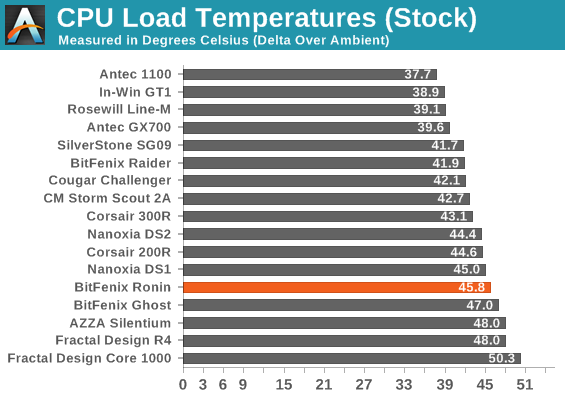
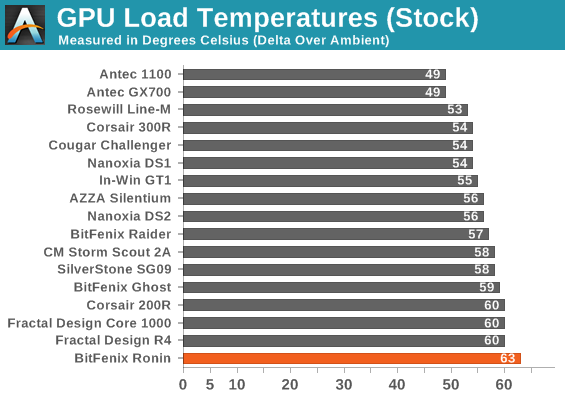
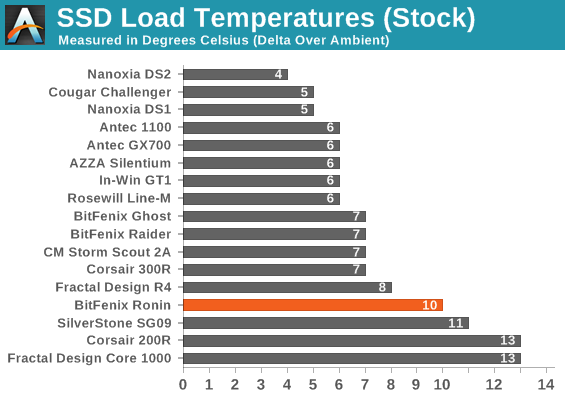
You can see stock cooling performance is pretty poor and easily bested by other, less expensive cases.
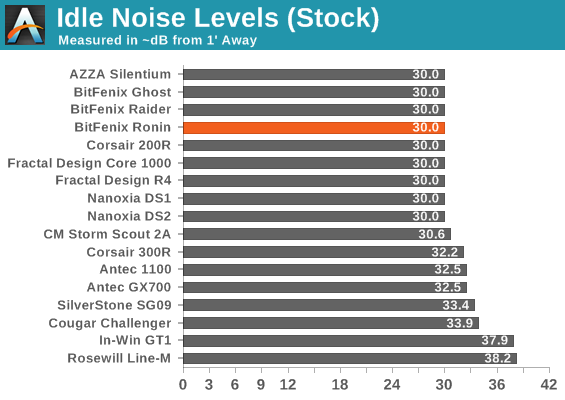
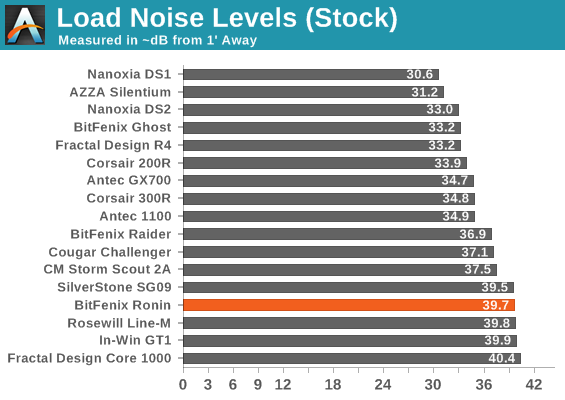
The poor thermal performance could at least be justified if the Ronin did a better job with noise, but it's just not there in any capacity and it only gets worse when you overclock the testbed.
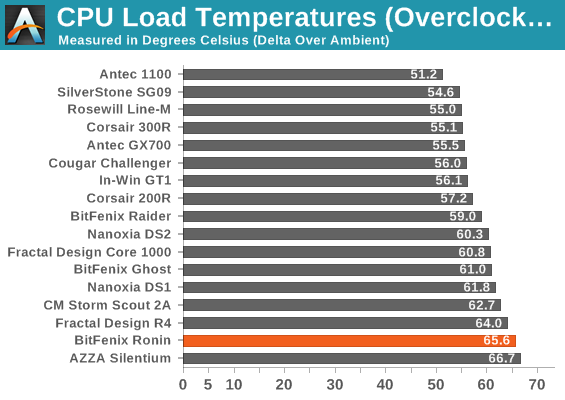
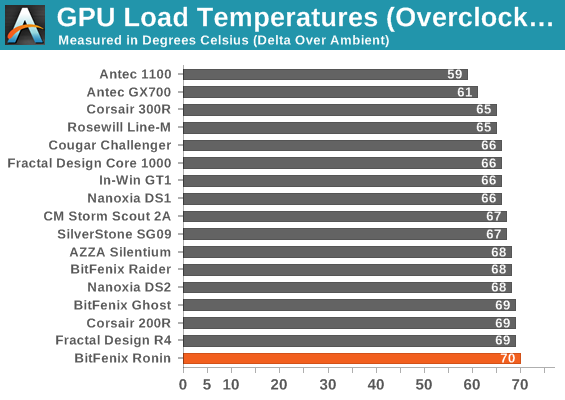
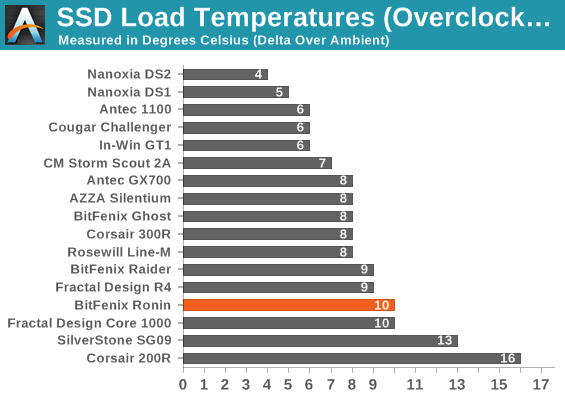
Overclock the testbed and suddenly the Ronin is finishing dead last. The two Spectre fans just aren't up to the task of keeping the system cool. Low case volume and low airflow are a deadly combination.

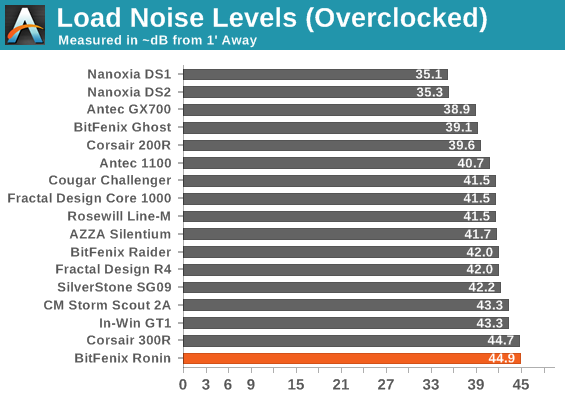
Noise levels are unfortunately unsurprising. The Ronin just runs hot and loud under load.
It's hard not to feel at least a little disheartened by these results, and I went into full fat testing with some trepidation.
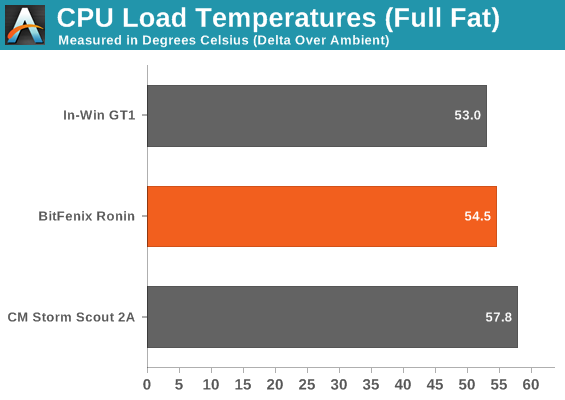
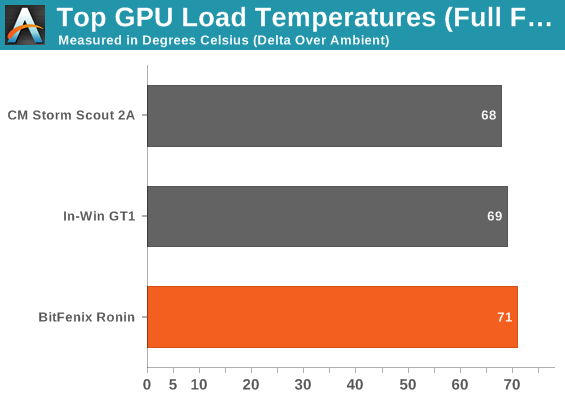
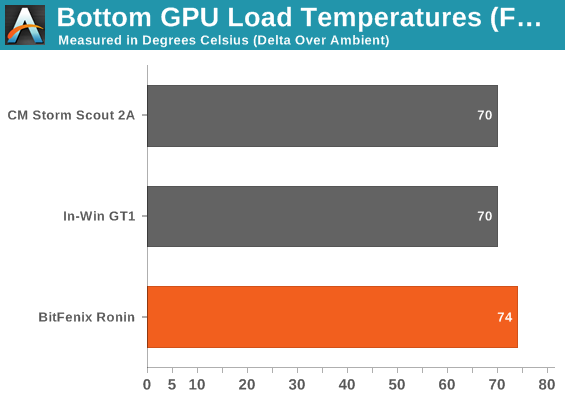
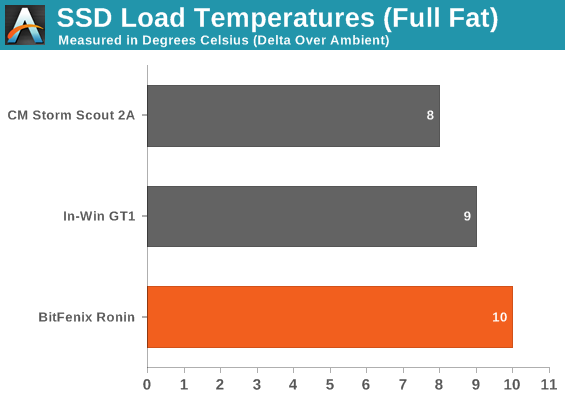
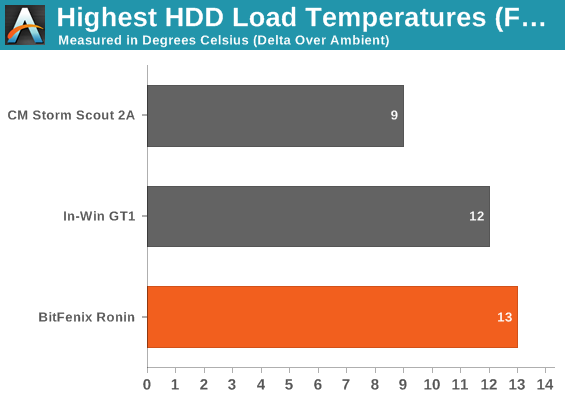
Note that the CPU runs hotter under load in our basic overclocked testbed than in our full fat despite the fact that it's running at the same voltage and speed in both. The GTX 580 blower-style coolers are able to pull much more weight than the GTX 560 Ti's open air cooler, keeping the Ronin from cooking the CPU. Unfortunately, the GPUs are running toasty in the process, hitting the 90s under load and actually maxing out their fan speeds.

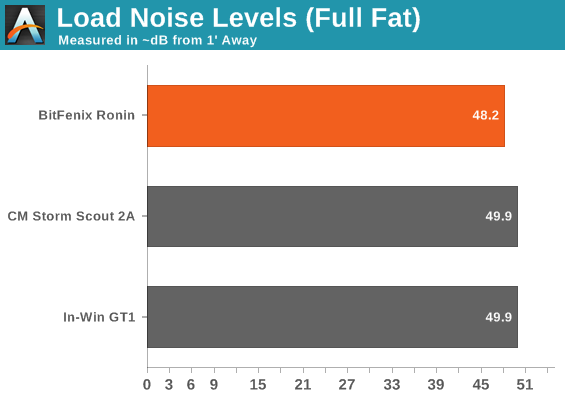
It's "quieter" than the other cases in its class, but that's not saying much. The fact remains that airflow is a serious issue in the Ronin.










30 Comments
View All Comments
Liquid_Static - Monday, July 22, 2013 - link
Disappointing to say the least. It seems like it's been a long time since we've seen any REAL innovation in the desktop case market, and frankly this was a step backwards. Although I do like the smaller size, the way it was implemented here (at the expense of temperature and noise levels) is not necessary or acceptable.Kaihekoa - Monday, July 22, 2013 - link
Check out the Corsair Carbide Air 540. It's been receiving great reviews everywhere, has great thermal performance, immense functionality and versatility, and looks mean. There isn't much room for major innovation in a product whose function is to hold your components, but the Corsair case separates your heat-producing components from your PSU, 5.25" drives, and all your cabling/wiring and then blows a lot of cool intake air across your CPU/GPU. Really I think the last time there was a major innovation in cases was the Silverstone FT02, but Silvertek has abandoned the 90 degree inverted motherboard principle in its latest Fortress & Raven enclosures.Liquid_Static - Monday, July 22, 2013 - link
I have a Corsair 500r, and I love their enclosures, however even they were getting stagnant up until the Air 540. I'd certainly consider one if I didn't have to worry about where I was going to find space for the cube in my dorm room...ggathagan - Monday, July 22, 2013 - link
What areas of innovation would you expect to see?I'm not being snarky; I'm asking seriously.
I see comments like this fairly often with full ATX case reviews, but I don't see where there can be much innovation.
At a minimum, any ATX-capable case will have to accommodate:
an ATX motherboard, a decent size CPU fan/heatsink, a full size PSU, a fairly long GPU card, a single optical drive and a single hard drive of any size. Now add the space necessary to provide decent air flow from the case fans.
To me, it seems that the need to accommodate the above severely limits what can be done with the design.
Kaihekoa mentions compartmentalization; Apple, Antec and others have been doing that for some time, with varying amounts of success.
Others have discussed changing the number of 5.25" and 3.5" bays, but that's not really innovation.
Once you decide that you need to make room for even a single optical drive and a single hard drive of any size, you now have a fair amount of empty space that might as well be used for additional drives.
M-ATX and ITX form factors allow case makers to be more creative (FT03-MINI comes to mind), since users are focusing on minimal size and expect to give up some of the above for the privilege.
There are only two things I could imagine doing:
Taking a Fortress FT-02 and cutting off the drive bays to reduce the depth of the case.
There's enough room in front of the expansion slots to allow for a single 3.5 drive and a slim-line optical drive.
Similarly, creating an ATX version of the FT03/FT03-MINI
Lastly, the bottom line for any manufacturer is profit.
Any product they make must be sold in enough quantity to pay for itself.
For the ATX form factor, I have difficulty believing that there's a large enough market to justify the effort
Grok42 - Tuesday, July 23, 2013 - link
I would point to the new Mac Pro if you want to see innovation. The core machine is a beast and the design is 10" x 6", basically an over-sized coke can. No 5.25" drive in that thing, no 3.5" drive either. Two GPUs and up to 12 cores for the CPU. Can the PC market do the same? Probably not without giving up important values such as open designs, but the answer isn't to keep doing the same thing. mITX is a pretty good platform, we just need more innovation around the form factor. Much more can be done to make the essential MB + CPU + GPU + SSD combo more integrated and streamlined.fluxtatic - Tuesday, July 23, 2013 - link
Innovative? Arguably. A disaster in a real-world environment? Probably. Expansion is pretty well Thunderbolt only, so the good looks (if you find fancy garbage cans attractive) will be wrecked by the cable running to a snarl of external drive bays, HDD enclosures, etc. Might not be a big deal for the sorts that actually need a Mac Pro, but I'd just as soon not drop half again the money on what I'd need to make it useful (storage, etc, from massively expensive TB accessories).ioconnor - Tuesday, July 23, 2013 - link
What areas of innovation would I like to see?1) Separate area to store the extra cables for the power supply, motherboard, etc.. For the extra screws. For the zip ties. For the manuals, instructions, and software. (It's always nice to store the windows OS CD with the computer it goes with.)
2) Super large slow moving fans.
3) Detachable L-plate the motherboard and cards attach to. So the L-plate is put on the desk, motherboard and cards are attached, then the L-plate is put back in case. The L-plate should be easily, under 5 seconds, removed or installed into the case.
4) The case should be made of thick aluminum and no sharp corners. Things should be spaced nicely so those of us with huge hands and arms can still work comfortably. Without tools.
Those are just some of the things that come immediately to mind. I could go on though.
1Angelreloaded - Tuesday, July 23, 2013 - link
So you basically want a case from Mountain Mods for cheap.cjs150 - Tuesday, July 23, 2013 - link
ggathagan: The sum total of innovation in ATX cases over last 10 years has been to move the PSU from the top of the case to the bottom. Both Silverstone and Lian Li have experimented but I have issues with the build quality of both.Obvious areas of potential innovation:
1. Turning PSU 90 degrees for better cable management. (Lian Li have tried this)
2. Noise dampening for optical drives
3. Proper cable routing on back side of motherboard tray
4. Some thought applied to cable routing for hard drive cages, maybe all fed of a single molex.
5. Given the weight of some GPUs some form of support - again I think Lian li have tried this
Heck: it is only in last 3 years that fan filters have become standard
lwatcdr - Friday, July 26, 2013 - link
Optical drives are not long for this world.There is a real limit to what you can do with a case. The big change I would like to see is in the power supply I would like the cables to come out the left hand side of the power supply so you can run them right to the back side of the motherboard tray. Then relocate the fan from the bottom to the front of the power supply. This would allow you to mount the drive bays in front of the power supply on the bottom and have the PS draw air over the drive bays. This would allow room long video cards and water cooling in the front of the case and maybe the top as well. Of course I would like to see a new SATA connector that supplies power as well so you only need one cable going to the drives.